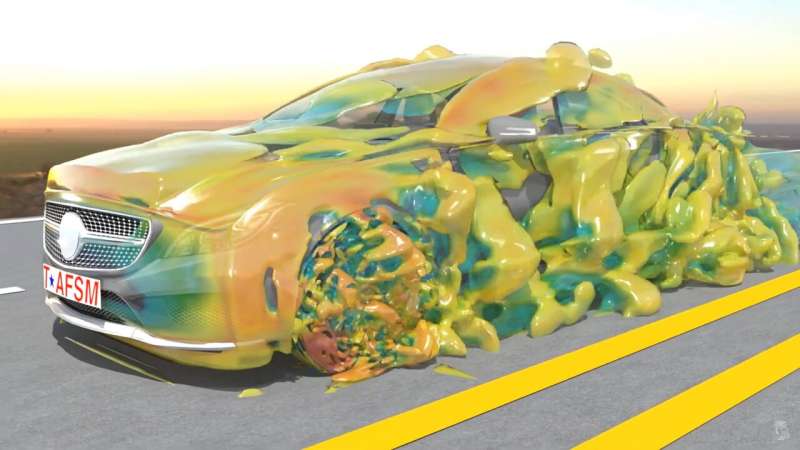Sophisticated fluid mechanics model: Space–time isogeometric analysis of car and tire aerodynamics

The complex aerodynamics around a moving car and its tires are hard to see, but not for some mechanical engineers.
Specialists in fluid dynamics at Rice University and Waseda University in Tokyo have developed their computer simulation methods to the point where it's possible to accurately model moving cars, right down to the flow around rolling tires.
The results are there for all to see in a video produced by Takashi Kuraishi, a research associate in the George R. Brown School of Engineering lab of Tayfun Tezduyar, the James F. Barbour Professor of Mechanical Engineering, and a student of alumnus Kenji Takizawa, a professor at Waseda and an adjunct professor at Rice.
"He has been escalating the complexity of his calculations, starting with a stand-alone tire and now having the rest of the car," Tezduyar said of Kuraishi, who joined the Rice lab in 2020 and is co-supervised by Tezduyar and Takizawa.
The video also demonstrates the efficacy of the NURBS Surface-to-Volume Guided Mesh Generation method, a technique developed by the Team for Advanced Flow Simulation and Modeling co-led by Tezduyar and Takizawa to model flow dynamics around and through complex-geometry objects. NURBS stands for Non-Uniform Rational Basis Splines, a mathematical technique to describe 3D shapes and provide computational analysis of fluid and structural mechanics problems involving such shapes.
An earlier video of fluid flow in a beating heart showed the "through." The new simulation shows what's actually happening around a moving object, in this case the extraordinary activity around a common subject. Complicating the model is the fact that the tires are in contact with the road and deform as they roll.
"We're dealing with near-actual car and tire geometries," Tezduyar said.
A detailed description of the methods and the car simulation was published last month in the journal Computational Mechanics. Since then, the Rice-Waseda team made the video to bring the illustrations to life.
"Knowing the airflow behavior around the car and its tires will lead to better understanding of their aerodynamic performance," said Kuraishi, who earned undergraduate, master's and Ph.D. degrees at Waseda and spent a year as a postdoctoral researcher there with Takizawa before coming to Houston. "Simulations this sophisticated are important to provide realistic solutions and reliable answers in design and performance evaluation."
Tezduyar, whose lab has also modeled recovery parachutes for NASA's Orion capsules, said NURBS use in computational analysis has grown dramatically in recent years, combining efficiency and accuracy by lowering the number of "mesh" points necessary to model a system. Think of the mesh as a net of fluid (like air) around an object, with the mesh points living in 3D "elements." The points and elements move when the object moves.
In one model of a moving car, the computational flow analysis with NURBS was achieved with about 1.1 million points, a fraction of the number used in customary methods, while retaining its accuracy. That lowers the computational cost as well, Tezduyar said.
"We have a 3D mesh around the car and the tires, with more points near the tire surfaces for higher accuracy where it matters more," he said. "As the tire rotates, the points and elements rotate with it, but the problem is that as the tire rotates, the elements moving under the tire collapse—and this is what other methods cannot handle. Our method does, and it is key to getting an accurate simulation."
As with the heart study, Tezduyar said their team is eager to collaborate with scientists and industry to model complex systems, including tires and vehicles.
"As time passes, naturally, new tire designs or improvements will be considered," he said. "It would be very beneficial for tire manufacturers to do this type of simulation before they invest in generating a prototype, because it would give them comprehensive and detailed numerical data about the aerodynamics around the tire that would be difficult to get in any other way."
More information: Takashi Kuraishi et al, Space–time isogeometric analysis of car and tire aerodynamics with road contact and tire deformation and rotation, Computational Mechanics (2022). DOI: 10.1007/s00466-022-02155-0




















